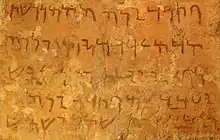Kesecek Köyü inscription
The Kesecek Köyü inscription is a 4th century BCE Aramaic inscription originally located on the cliffs overlooking the Berdan River near the village of Kesecek Köyü about 25-35 km north-east of Tarsus, Mersin.[1][2]

The inscription
It is similar in nature to the Sarıaydın inscription.[3]
The inscription measures 46 cm wide by 30 cm high. It is known at KAI 258.
It is currently at the Peabody Museum of Natural History at Yale.
Bibliography
- Charles Cutler Torrey, "An Aramaic Inscription from Cilicia, in the Museum of Yale University" JAOS 35 (1915): 370–74
- Hanson, R.S., "Aramaic Funerary and Boundary Inscriptions from Asia Minor." BASOR 192 (1968): 3–11. Kesecek Daskyleion LimBil GozBdSt
References
- Charles Cutler Torrey, "An Aramaic Inscription from Cilicia, in the Museum of Yale University" JAOS 35 (1915): 370–74: "The ancient Aramaic monument described in the following pages was brought to the United States recently by an Armenian merchant, and was purchased in 1915 by Colonel Isaac Morris Ullman of New Haven for the Museum of Yale University. It is a block of yellowish gray flint, said to have been cut out of a cliff above the river Cydnus, in the neighborhood of the village Kesejek Keoyew, about fifteen miles northeast of the city of Tarsus."
- Butterweck, Christel; Conrad, Diethelm; Delsman, Wilhelmus C.; et al. (8 July 2019). Grab-, Sarg-, Votiv- und Bauinschriften (in German). Gütersloher Verlagshaus. p. 578. ISBN 978-3-641-21767-9.
- Charles Cutler Torrey, "An Aramaic Inscription from Cilicia, in the Museum of Yale University" JAOS 35 (1915): 370–74: "Of the inscriptions hitherto published, those most nearly resembling ours in the forms of the characters used are the Memphis inscription, CIS II, 122, dated 482 B. C, the Teima stele, CIS II, 113, belonging to the fifth century, and the Cilician hunting inscription, Lidzbarski, Kandbuch, Plate XXVI, 3, probably also dating from the fifth century."
This article is issued from Wikipedia. The text is licensed under Creative Commons - Attribution - Sharealike. Additional terms may apply for the media files.